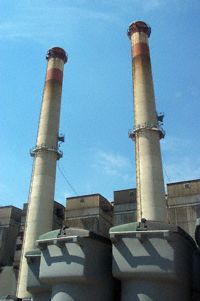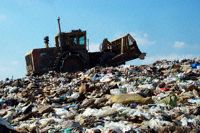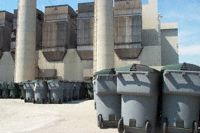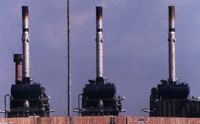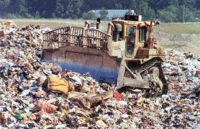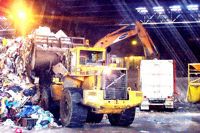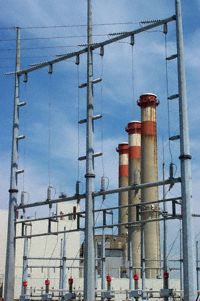Clean Sweep
A look at the dirty business of keeping our neighborhoods clean
In an era of increasing awareness about the need to balance both economic growth and stability with environmental protection, the American society has been trying to find ways that foster both needs. The time of the uncompromising conflict between the so-called heartless capitalist and the naïve tree hugger is giving way to a more intelligent approach to the need for both development and conservation.
While the sides still call from opposing political camps, there is a sense that most capitalists do have a heart for the world, and that even organized conservation groups are leaning to the middle ground that realizes that human society is as much a part of the world as rainforests.
In 1989 the Ohio General Assembly passed House Bill 592 to address the issue of waste management—at the time Ohio was projected to run out of landfill space by 1996. When signed, the counties of Ohio formed associations called solid waste districts. Most of the solid waste districts encompass multiple counties.
Franklin County, along with four other counties, opted to form a solid waste authority instead of a district. This authority, run by a nine-member board of trustees, is called the Solid Waste Authority of Central Ohio.
SWACO runs a number of operations in Central Ohio, from the county landfill on Route 665 to composting facilities, waste transit stations, and educational programs.
 SWACO director Michael Long said, "The main goal of SWACO is to develop and implement waste reduction and recycling programs that fall in line with the state goals.”
SWACO director Michael Long said, "The main goal of SWACO is to develop and implement waste reduction and recycling programs that fall in line with the state goals.”
In 1993 the Ohio Environmental Protection Agency approved the SWACO plans that spanned to 2008. According to SWACO, the original plan objectives, which were set for 1996, were met in 1996. The plan, which must be updated every five years, was then updated in 1998, with a set of goals measured against the information collected in 1996.
The amended plan noted, "The quantity of commercial wastes generated in the District is much higher than the national average.”
In 1996, the combined national average of residential and commercial waste per person per day was 4.36 pounds. Within SWACO territory, commercial generation alone was 4.28 pounds per person per day, with a combined residential and commercial waste reaching 7.04 pounds per person per day.
The plan reported a notable increase in industrial waste during 1997 and 1998. The plan speculated, "The increase in industrial waste disposal may be attributed to the decline in market prices for recyclables and a drop in landfill disposal prices.”
Overall waste generation increases have been explained due to population growth and a strong economy and workforce through the 1990s. While a newly amended plan is currently under works for the next five years, current data is still being assessed, so it is not clear how the slowing economy is affecting waste generation in the district.
While the district has had higher than national averages, and total waste production rises due to growth, the plan’s reduction goals have been mostly met.While the numbers are still not completely in, Long said that the goals set for 2001 will be reached by the end of the year. The industrial sector has already reduced waste by 50%, although the residential and commercial sectors are trying to reach the goal of 25% reduction. To meet the residential goal, waste reduction in 2001 must reach 382,275 tons. Long feels SWACO will meet that goal.
SWACO overview
SWACO was formed in 1989 following the passage of House Bill 592. In 1991 SWACO purchased the Franklin County Sanitary Landfill in southern Franklin County, along with the derelict Model Landfill nested between Route 104 and I-71.
It was up to SWACO to find ways to prolong the life of the active landfill, as well as find a use for the closed Model Landfill.
Part of the strategy has been to promote recycling. But as recycling is as much an issue of educating communities and individuals about the issues in waste management, other plans had to be implemented before the effects of education could kick in.
 SWACO management opened two composting facilities that have diverted as much as 100,000 tons per year of yard waste that would otherwise make its way to the landfill.
SWACO management opened two composting facilities that have diverted as much as 100,000 tons per year of yard waste that would otherwise make its way to the landfill.
In 1993 SWACO acquired the trash burning power plant called the Waste-To-Energy Facility from the city of Columbus. The plant was built in the 1970s, and turned 2,000 tons of trash a day into 90-megawatts of power.
When SWACO issued a $49 per ton waste generation fee to cover the cost of operating the Waste-To-Energy Facility and bring it up to current federal clean air requirements, a federal district court repealed the fee. For financial reasons SWACO shut down the plant in 1994. Columbus held SWACO to the lease agreement, and SWACO to this day is paying Columbus off for the deal. SWACO still owes Columbus $100 million for the plant, but there is no current deadline to pay off the bill.
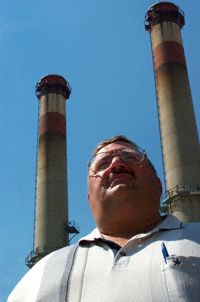 Rick Dodge was the plant chemist, but now works as the SWACO director of operations. He felt the plant was a good idea, but unexpected maintenance issues inflicted heavy costs. Part of the problem was that the shredders often clogged. Dodge feels that financial burdens were more significant in the plant’s closure than pollution concerns.
Rick Dodge was the plant chemist, but now works as the SWACO director of operations. He felt the plant was a good idea, but unexpected maintenance issues inflicted heavy costs. Part of the problem was that the shredders often clogged. Dodge feels that financial burdens were more significant in the plant’s closure than pollution concerns.
Dodge said the level of toxin in the soil around the plant was not found to be much higher than the surrounding soil.
Now SWACO uses the unused power plant as a storage facility and as a transit station for Columbus waste on its way from city haulers to the landfill.
Currently seeking a tenant for the power plant, SWACO hopes that an industrial need can be filled at the location. Companies have expressed interest in the location in the past, but no one has yet signed any agreements. Such a tenant would help SWACO meet its obligation to Columbus.
Just south of the plant lay the old Model Landfill. Long and his staff sought a beneficial use of the site. A solution arose when Petro Environmental Technologies recommended installing gas collectors that could translate the trash-produced gases into energy. SWACO was already burning the methane as it vented the site.
The site was cleaned and landscaped for the Phoenix Links Golf Course. The gas collection at Phoenix produces 3.9 megawatts of energy per day, which supplies power to several thousand homes.
While the gases are expected to curve off by 2009, Dodge said, "They could generate more electricity, as there's more gas capacity than there is generator capacity.”
Similar technology will be used at the sanitary landfill in the future to collect methane, said Long with a glimmer of excitement. "It’s a very valuable commodity. We are a huge producer of methane, and there’s virtually no methane produced in the U.S.” Installation of gas collection has already started.
The sanitary landfill currently covers 116 acres of ground and rises to 1,010 feet above sea level. The base is 180 feet below. Filled to its maximum capacity, the landfill could cover 363 acres and rise to a total of 195 feet.
That’s something that none of the SWACO staff wants. Long said, "We’re trying to reduce reliance on landfills.” Dodge feels that the only reasons landfills are the best option right now is due to cost factors. The hope of SWACO and like organizations is that better and cheaper methods are found to handle waste. The key element right now seems to be recycling.
Promoting recycling
Perhaps the most challenging goal in SWACO’s strategy is getting waste generators to recycle. While the industrial sector has accomplished a 50% reduction in waste production since 1996, the residential and commercial sectors seem to need more prodding.
Providing recycling facilities and support throughout the district has been a primary focus to reach that goal.
The first strategy SWACO pursued under the amended 1996 plan was raising number of recyclable drop-off locations around Columbus. By 1999 there were 49 drop-off locations in Columbus that took in glass bottles, aluminum and other steel cans, plastics, and mixed residential papers such as newspapers, magazines, telephone books and junk mail.
By 2001 the projected rate was that SWACO would be diverting 7,119 tons of recyclable material from the landfill. SWACO exceeded that goal, reaching 9,110 tons of diversion from the landfill
Columbus had contracted with Rumpke to collect the recyclables. On February 4 Columbus City Council transfered the contract for collection to SWACO.
SWACO set up twenty-eight collection centers around Franklin County to provide service to multi-family housing complexes to promote recycling. In 1997 SWACO encouraged Columbus to offer its residents free curbside yard waste collection. This plan doubled the amount of yard waste Columbus sent to SWACO composting facilities.
A further effort related to this is SWACO’s active encouragement for townships to develop waste collection contracts that include recycling and yard waste collection for all township residents. Madison, Hamilton and Clinton townships are currently the only townships to have these contracts. Other townships are considering this strategy, but there has been some controversy on the topic.
Working with local businesses that employ less than 250 people, SWACO initiated a program to help those businesses efficiently recycle paper. According to SWACO, these businesses recycled 261 tons of paper in 2001. By participating in the program the businesses benefited by losing disposal costs and receiving a portion of the revenue for the sale of the paper.
Trying to find new ways of getting people to recycle more, SWACO and Columbus ran a test program with a special kind of trash bin that disposes into a dual-collection vehicle.
Long said, "There’s a huge inefficiency in how garbage has traditionally been collected.” In the traditional pick-up, there can be as many as three trash trucks that come by a home to pick up household waste, recyclables, and yard waste. That adds up to a large cost in labor, fuel and equipment.
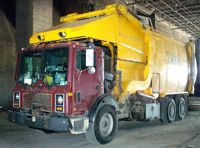 In the dual-collection test, special bins were provided to 3,000 homes in Columbus for six months. A special truck provided by the Moriah company collected the waste. Long said this test produced a 35% diversion of recyclables from the landfill.
In the dual-collection test, special bins were provided to 3,000 homes in Columbus for six months. A special truck provided by the Moriah company collected the waste. Long said this test produced a 35% diversion of recyclables from the landfill.
New Albany recently ran a similar test. While the numbers are still being analyzed, Long said they are looking good. The hope is that enough community interest is raised to prod waste hauling companies to purchase these trucks.
According to Long, the study showed that the dual-collection system diverted 30% of the waste that would have gone to the landfill. Traditional curbside service reaches 15-20% diversion.
The hesitation now is that the dual-collection vehicles cost as much as $40,000 more than standard collection vehicles.
Long said, "I personally believe that dual-collection is the way of the future.”
Benefits go beyond efficiency and cost reduction for SWACO. Engineers have stated that waste trucks pay a heavy toll on roads. Reducing the number of trucks that run down a road increases the lifespan of roads.
As time goes on SWACO intends on doing all it can to divert as much as possible the amount of waste that goes to the landfill. Long, who has been the director of SWACO since its inception, admits that he is no tree-hugger. He said his responsibility is to run the operations of SWACO as professionally as possible as he leads the organization down paths that meet state and federal mandates.
"It just makes sense,” said Long.
Diverting waste from the landfill is a primary goal because of the simple fact that space literally is finite.
There are other landfills in the area owned by private corporations. Keeping the SWACO landfill open as long as possible helps keep costs low, said Long. Run at a cost of operation level, the sanitary landfill charges only as much as it costs to operate. This means that for anyone having a contract with SWACO, the cost of dumping at SWACO is $27 per ton. For those with no contracts, the fee is $29.25 per ton. The average homeowner produces one ton of trash per year.
Long warns that if no other method is found to deal with waste removal, and the SWACO landfill fills up, other landfills will be able to raise prices. And while most homeowners don’t dump their trash personally, the cost will make its way back to the homeowner. The landfill will last at least another 40 years, said Long, but planning for the future starts now.
For more information about SWACO go to www.swaco.org.
The information collected for this article was gathered in late 2001 and early 2002.
- Related Topics

